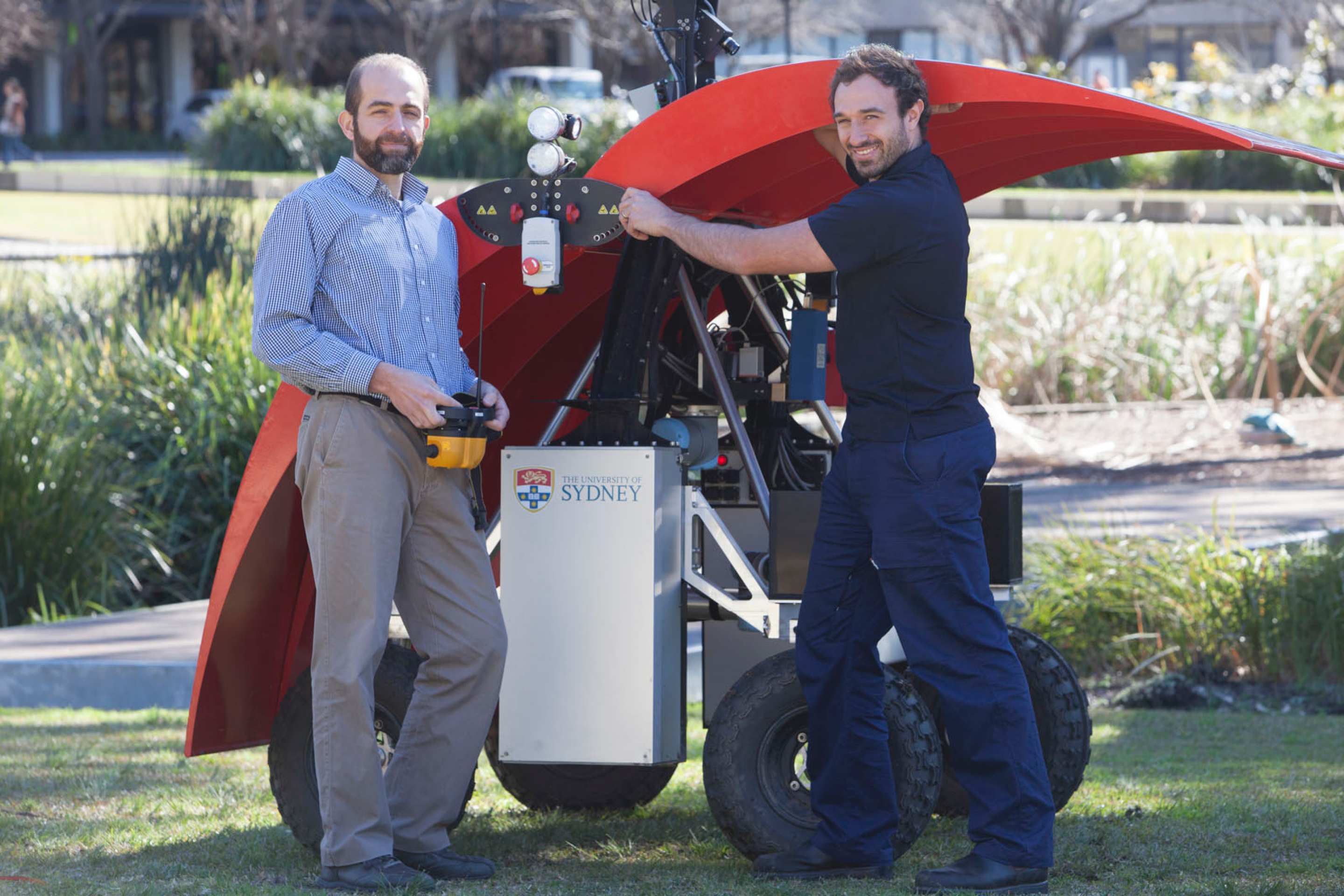Philanthropy backs bots
Anonymous $1.5 million donation to robotics research aims to make technology accessible to the average Australian farmer.

Professor Salah Sukkarieh and Mark Calleija work on the Ladybird
Project co-ordinator Salah Sukkarieh Professor of Robotics and Intelligent Systems, and Director of Research and Innovation at the Australian Centre for Field Robotics says the affordable Farmbots will give farmers a tool to help better manage their farms.
“It will also help them reduce the time spent on laborious farm duties, crop and animal monitoring, as well as invasive pest management,” he said.
“The technology will provide our farming community with low-cost platforms that can be adapted easily to meet the farmer’s individual needs.
“The new technology will assist agriculturalists in taking their farms into the future as well as provide an education tool for the next generation of growers.
“We will develop two low-cost Farmbot devices – the EmuBot™ and the KangaBot™. The platforms will be rugged, robust, battery and solar powered, energy efficient, simple to operate, and easily adaptable to meet different faming needs,” Professor Sukkarieh said.
The two variants will capture a wide range of agriculture applications from livestock, to tree crops and vegetable rows.
“We want to give all farmers the opportunity to have access to transformational technology by creating an affordable robot,” says senior technical developer Mark Calleija.
“Access to low cost robots would positively impact the quality of life for our farmers and their communities.
“It would help them address input and labour costs and improve efficiencies.
“It will also provide a generic platform that will enable farmers to grow technological capability on their farms as well as provide an educational tool for next generation growers.
“The mainstream use of agricultural robotics will also encourage a renewed interest in farming and attract a new technology-savvy generation back to the farm,” said Calleija.
With Australia’s population expected to reach around 38 million by 2060 the Australian Productivity Commission’s July 2015 update report said future growth in Australia’s agricultural sector “is likely to depend on the more productive use of land, water and other natural endowments through the application of the most up-to-date equipment and technologies against the background of changing productive potential.”
Professor Archie Johnston, dean Faculty of Engineering and Information Technologies, said this type of generous donation would accelerate researchers’ efforts in working collaboratively with industry groups to deliver innovative technologies that will inevitably revolutionise farming techniques.
With every gift to the University of Sydney, donors become part of INSPIRED – the Campaign to support the University of Sydney, which aims to raise $600 million by 2017.
Related articles
Resetting the table to halt expanding waistlines
Can farmers, producers and regulators work together at all points of the food supply chain to help curb Australia's growing obesity problem?

Sydney's cyclists twice as happy as other commuters: new research
Sydney's commuting cyclists are twice as happy as people who drive, walk or use public transport to get to work, University of Sydney research reveals.
'Passion' key to being a successful leader
Leadership is about following a passion, having a belief in what you're doing and understanding that people matter, explained NSW Premier Mike Baird at the latest BOSS Emerging Leaders event.
Sydney alumni echo our vision of leadership
We celebrate the achievements and values of our students and alumni in a campaign that rolled out on campus, online, and on train stations, buses and street posters across Sydney last week.
Eureka Prize for Associate Professor Michael J. Biercuk
Associate Professor Biercuk was recognised with the prestigious prize for contributions at the leading edge of quantum science research.
Legal risk in bombing Syria
The government faces some thorny legal questions as the fight against Islamic State draws our troops towards Syria, writes Malcolm Jorgensen.
Athletes score for disability and donors
Wheelchair basketball athletes from the NSW Institute of Sport and Wheelchair Sports NSW showed their support for the Pave the Way campaign this week.
Scientists should take a leaf out of wellness bloggers' books
How can we distinguish credible wellness information from unfounded pseudoscience? And why is it that wellness gurus are often taken more seriously than scientists? Jackie Randles writes.
Seventeen at Belvoir – a brilliant theatrical event with a happy, hetero ending
"As a gay man watching the play's ending, I felt I'd seen this story too many times to feel part of its investments in the future," writes Dr Huw Griffiths.
Ping pong diplomacy
Vice-Chancellor Dr Michael Spence and Chinese Consul General Li Huaxin faced off in a friendly ping-pong match this week.
